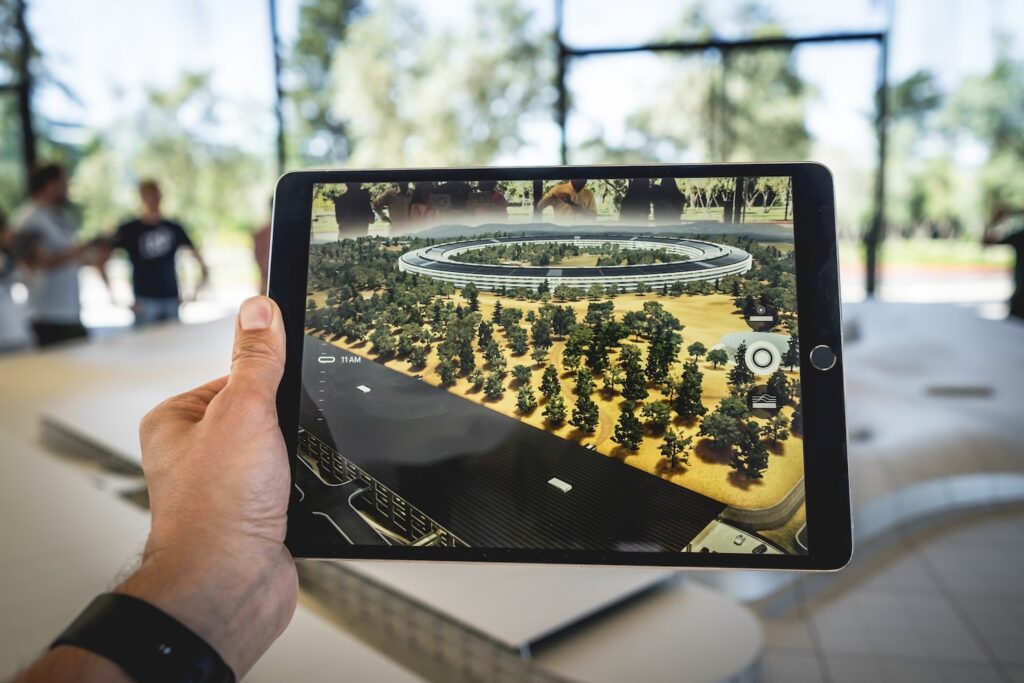The Rise of Augmented Reality in Web Design

In recent years, augmented reality has emerged as a transformative force, reshaping the way we interact with the digital field. Defined as the integration of virtual elements into our physical environment, it enriches our sensory experiences by overlaying digital information onto the real world. So, it’s no wonder the technology has successfully made its way to web design.
In this article, we’ll explore the rise of augmented reality technology in web design and the intricacies of its integration into the realm of web engineering.
Understanding Augmented Reality
Augmented reality (AR) stands at the intersection of the physical and digital realms, offering a dynamic and interactive overlay of computer-generated information onto our perception of the real world. Unlike virtual reality (VR), which immerses users in entirely virtual environments, AR enhances the existing reality by supplementing it with simulated sensory inputs.
Computer simulation effects are achieved through the utilization of specialized hardware, such as AR-enabled devices like smartphones, tablets, or dedicated headsets. These devices employ an array of sensors, cameras, and algorithms to detect and analyze the surrounding environment, allowing for the seamless integration of virtual objects, graphics, and animations.
AR technology not only recognizes and tracks physical surfaces and objects but also adjusts virtual elements in real time to align with changes in the user’s perspective. Such a dynamic interaction creates a remarkably immersive experience, enabling users to perceive digital content in a way that feels natural and intuitive.
Historical Context of Augmented Reality
The concept of AR can be traced back to the 1960s when computer scientist Ivan Sutherland introduced the world to the first head-mounted display system known as the “Sword of Damocles.” This rudimentary device laid the foundation for immersive computing experiences.
In the 1990s, Boeing researcher Tom Caudell coined the term “Augmented Reality” while working on a project that utilized head-mounted displays to aid assembly line workers by overlaying digital information onto physical objects. This marked a significant milestone in AR’s development, as it demonstrated its potential to enhance human capabilities in real-world environments.
The integration of AR into web design is a testament to the rapid advancement of technology. The creation of computer simulation software development kits (SDKs) and frameworks, such as Apple’s ARKit and Google’s ARCore, has streamlined the process of creating AR applications. These platforms provide a robust set of tools and APIs, allowing developers to build virtual experiences with relative ease.
Recently, web technologies have also evolved to support AR integration. WebAR, a subset of AR, leverages standard web technologies like HTML, JavaScript, and WebGL to deliver simulations directly through a web browser. This eliminates the need for users to download dedicated apps, making virtual effects more accessible and user-friendly.
The Intersection of AR and Web Design

Traditionally, websites have been limited to two-dimensional interfaces, relying on text, images, and videos. AR revolutionizes this paradigm by introducing a new dimension to web design. It empowers designers to create interactive and engaging experiences that bridge the gap between the virtual and physical worlds.
When a user accesses an AR-enabled site, the browser utilizes the device’s camera and sensors to scan and interpret the surroundings. Virtual objects or information are then superimposed onto the live video feed, creating a composite view that seamlessly blends the real and virtual worlds. As such, AR extends the boundaries of interaction by allowing users to engage with content in three dimensions, within their own physical space.
AR-powered web design offers a wide array of applications across various industries. From e-commerce platforms allowing customers to visualize products in their own space to educational websites providing interactive learning practices, the potential for simulated reality to enhance user engagement and satisfaction is boundless.
Moreover, this tech enables businesses to differentiate themselves in an increasingly competitive online landscape, providing a unique and memorable user experience that sets them apart.
While the adoption of AR in web design can be transformative, successfully implementing it requires expertise. It’s crucial for businesses to hire web developers who are skilled in integrating AR functionalities seamlessly into websites. With the right team of developers, companies can ensure that their AR-enabled websites provide an optimal user experience, maximizing the potential of this innovative technology.
AR Benefits in Web Design
By 2025, 25% of leading brands are expected to make computer simulations an integral part of their website interfaces which is no wonder since AR integration into web design offers a host of advantages that enhance user experiences and give businesses a competitive edge.
Enhanced Engagement and Interactivity
One of the primary benefits companies will reap by incorporating virtual effects into interface design is the increased level of engagement and interactivity it provides for users. Interactive elements prove to increase user engagement by nearly 50% and boost user retention rates by 60%.
- Immersive Experiences: AR transforms static content into dynamic, interactive materials. Users can engage with virtual objects, explore products, and interact with digital elements in their physical environment. Such increased interactivity fosters a deeper level of engagement compared to traditional web interfaces.
- Spatial Awareness: The tech provides users with a sense of spatial context by overlaying simulated content onto their physical surroundings. Spatial awareness enables users to visualize how products or information relate to their real-world environment, enhancing comprehension and decision-making.
- Gamification and Entertainment: Computer simulation introduces gamification elements, turning interactions into playful experiences. This can be particularly effective for educational platforms, marketing campaigns, and entertainment websites, encouraging user participation and enjoyment. iGaming development also harnesses the power of computer simulation. By introducing gamification elements, turns user interactions into enjoyable and playful experiences.
- Dynamic Feedback: AR offers real-time feedback based on user interactions. For example, in a virtual dressing room scenario, users can see how different clothing items fit and move as they adjust their position, providing immediate and valuable insights.
Personalized User Experiences
In 2023, over 68% of web designers view user experience as a top priority when developing sites. In the meantime, AR-driven web design allows for tailored experiences that cater to individual preferences and needs, which, in turn, greatly amplifies overall user interest and experience. Here is how it’s achieved.
- Product Visualization: In e-commerce, AR enables users to visualize products in their own environment before making a purchase. This individualized approach enhances confidence in product selection and reduces the likelihood of returns.
- Customizable Content: Simulated reality can adapt content based on user behavior, preferences, and location. For instance, a travel website can offer personalized recommendations and information about local attractions using virtual overlays.
- User-Centric Learning: Educational platforms can use AR to create custom learning practices, adapting content to the user’s pace, learning style, and level of understanding. This fosters a more effective and engaging learning environment.
- Accessibility Features: In the context of e-commerce and magento security services, AR can also enhance user accessibility features. AR can be used to provide customized accessibility options, matching users with specific needs. For example, the tech can assist visually impaired users by providing audio descriptions of visuals.
Competitive Advantage and Brand Differentiation
AR in web design is a powerful tool for businesses to be at the forefront of innovation and stand out in a crowded digital landscape.
- Memorable User Experiences: Offering AR-enhanced experiences sets a brand apart and leaves a lasting impression on users. This unique and memorable interaction can lead to increased brand loyalty and word-of-mouth referrals. And over 92% of consumers are attracted by word-of-mouth referrals more than by other types of ads.
- Innovative Brand Image: By adopting computer simulations, a brand showcases a forward-thinking and tech-savvy image. This perception of innovation can attract tech-savvy audiences and position the brand as a leader in its industry.
- Market Differentiation: In competitive markets, AR can be a game-changer. It provides a distinct value proposition that competitors may not offer, giving the business a competitive edge.
- Increased Conversion Rates: The interactive and personalized nature of virtual experiences can lead to higher conversion rates. Users who engage with AR are more likely to make informed decisions and complete desired actions, such as making a purchase or signing up for a service.
Use Cases for AR in Web Design
Offering multiple benefits to businesses, AR integration in web design finds diverse applications across different industries. Many bigger brands have already embraced this trend in their websites to provide a unique browsing experience to their users.
- Ikea Place: Ikea’s AR application allows users to visualize how furniture and home accessories would look and fit in their own spaces before buying the items. By using the camera on a mobile device, customers can place virtual objects in their real environment, allowing for a more accurate assessment of scale and style.
- Sephora Artist: Sephora’s AR tool enables customers to try on makeup virtually. They can experiment with different shades of lipstick, eyeshadow, and other cosmetics. The simulated reality technology maps facial features and overlays virtual makeup products, providing a realistic representation of how they would look in reality.
- Converse Shoe Try-On: Converse’s computer simulation allows consumers to virtually try on different shoe styles, providing an interactive and personalized shopping experience. By scanning their feet using a mobile device camera, customers can see how various Converse shoe models fit and look on their own feet.
- Google Maps Live View: This feature integrates AR to help users navigate through cities and find their destinations more easily. By utilizing a smartphone camera, Live View superimposes directional arrows and location markers onto the real-world environment, providing visual cues for navigation.
- Air Jordan 3D Shoe Model: Nike introduced an AR experience that enables users to explore the Air Jordan III model in detail, including its design history and unique features. By scanning a QR code, users can place a 3D model of the shoe in their environment and interact with it through gestures and touch.
- BMW iVisualizer: An AR tool from a renowned automaker allows customers to explore and customize their dream car models in real-world conditions. They can use their mobile device or tablet to project life-sized virtual BMW models into their surroundings for a detailed examination of design elements.
To Conclude
Augmented Reality is poised to reshape web design, delivering unprecedented levels of interactivity, engagement, and personalization. As tech continues to advance, web creators have the opportunity to lead the way in creating innovative and immersive digital experiences that will shape the future of the online landscape. By staying informed, embracing new technologies, and prioritizing user-centric design, they can play a crucial role in this exciting evolution.
Featured image by Patrick Schneider on Unsplash